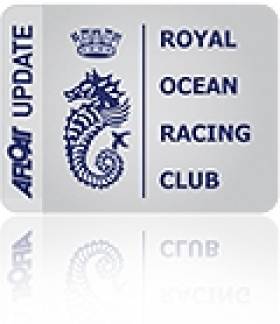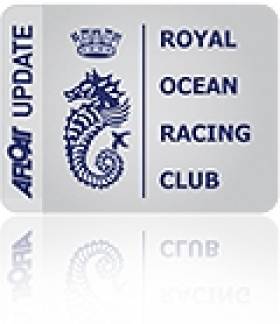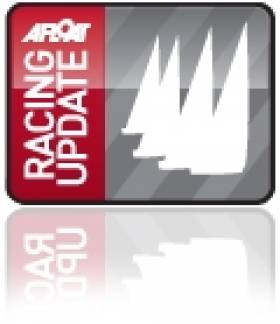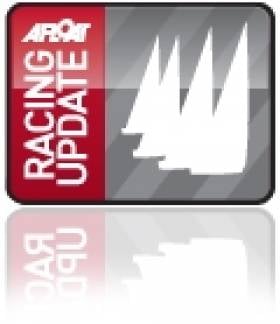Displaying items by tag: Solent
Three Volvo 70s Start the Fastnet Race (Pics here)
One of the most impressive sailing sights from the weekend was on the Solent yesterday when three Volvo Ocean Race 2011-12 entries Groupama Sailing Team, Abu Dhabi Ocean Racing and current leader Team Sanya started the Rolex Fastnet Race, the first full blooded test of the boats in the build up to October's start. Ireland has a sponsorship tie in with the Sanya entry and it also has an Irish media man onboard.
Second Irish Quarter Tonner Heads for Cowes
Following Monday's report on the Irish championship winning yacht Tiger (Neil Kenefick) sailing in the Quarter Ton Cup in Cowes next week a second Royal Cork Yacht, Eamonn Rohan's Quarter tonner 'Anchor Challenge' is also heading to the Solent. Her crew is made up of Eamonn, Nigel Young, Sam Hunt, Ian Travers and Mick Liddy. This boat won the event in 2009 so she has form. Watch this space!

Anchor Challenge is heading for Cowes. Photo: Bob Bateman. Scroll down for more.
Light Solent Winds Keep O'Leary and Dowling at Bay
RORC Easter Sailing Challenge – Day 2 Light winds are keeping Irish entries in the bottom half of the respective IRC fleets at RORC's Easter challenge this weekend. After four races sailed, Royal Cork's Anthony O'Leary lies sixth from ten boats in the IRC 1 division. In IRC 2 Dun Laoghaire's Niall Dowling sailing a brand new J111 also lies sixth from ten. James Boyd reports from the Solent: With a forecast indicating no wind on the Solent, the race committee and competitors were blessed in being able to get two races in on the second day of the RORC Easter Challenge, once again held in unseasonably summer-like conditions.
While the first start was scheduled for 1000, a windless Solent saw racing postponed for three hours. Competitors were kept occupied in the Cowes Yacht Haven Events Centre with a valuable talk from Jim Saltonstall on race preparation.
Early afternoon the race committee made the brave call to get underway on a course off Hill Head despite the apparent mill pond. In fact there was wind off the water and a meaningful race was held. As women's match racer Josie Gibson, helming the new Mat 1010 in IRC 3, observed: "It was really good of them to try and do it, because the alternative was to wait for the new breeze. It wasn't totally unfair but it was just very very light. There was an awful lot of shear. At the top we were getting 5-6 knots but it was really glassy on the water."
At the end of the first race the wind began to veer into the southwest as the sea breeze prevailed and for race two, the wind picked up to an unexpected 13-14 knots with the tide running left to right across the course on the beat. From the first race, where crews were being sat down to leeward, for race two they were up on the weather rail, fully hiking.
At the end of play, in IRC1 Mike Bartholomew's King 40 Tokoloshe now shares the top spot with Rob Gray and Sam Laidlaw's Farr 50, Bob, the biggest boat in the RORC Easter Challenge fleet.
"Sam sailed the first race and we got away quite nicely. She goes like a rocketship in the light stuff," recounted Gray of his Farr 50 which is looking very smart with a new paint job and, for this season, a stiffer mast, new mainsail and an enlarged asymmetric kite. "We were sailing faster than the apparent wind. Tokoloshe is sailing very very well. In the second race today she was way to the right and was first to catch the new breeze." The two boats share the top spot due to Tokoloshe posting a fourth in today's light opener.
In IRC Two, frustrating Andrew McIrvine in his second placed First 40 La Réponse, Andrew Williams' Prima 38 Max 'Ed Out! holds the lead having won both today's races, putting them two points ahead of the RORC Commodore. Williams and his crew have made the trip up from Plymouth to compete. For this season they have changed the name of their boat from Mighty Max III after they enlarged the size of their biggest spinnaker by 35%.
"This is the first time we have raced her with the new rating and it has made a tremendous difference," said Williams. In today's ultra-light first race Williams said it was all about keeping the boat moving. "She is a 14 year old design and we have had three firsts and a fourth, which for a scratch crew with a boat with a new sail configuration we've only been out once with - we feel quite pleased with the way she is performing."
Chris and Hannah Neve's high experienced crew on the Lymington-based First 35 No Chance are slipping away in first place in IRC 3 after posting a 2-1 today. They lead Louise Morton's Mat 1010 by three points. The RORC Easter Challenge is only Mat 1010's second competitive outing. The boat is being sailed by Morton's all-female crew that normally race on the Quarter Tonner Espada, with the exception of Volvo Ocean Race winning navigator Jules Salter, taking time off from his latest campaign with Abu Dhabi Ocean Racing. "This morning was quite like Abu Dhabi," quipped helm Josie Gibson.
IRC4 is the only class to have a run-away leader in Grant Gordon's J/97 Fever, now nine points clear of Paul Blowers and Nick Daniels Impala Patriot Games, while in the J/80s Kevin Sproul made a good come back after yesterday's rig issues to win both today's races.
Despite the light wind to start with today, the conditions once again proved ideal for the on-the-water coaching provided by Jim Saltonstall, Barry Dunning and their team. The RORC Easter Challenge is a 'coaching regatta' and the competitors have been lapping up the advice during races as well as the post-race video analysis ashore.
"Today was brilliant because you could concentrate on sail shapes and not get too distracted. At least you aren't battling around in survival conditions like you normally are," commented Ben Jones, the main trimmer on Mike Greville's Erivale of today's coaching. "It is always nice to have a view from outside of the boat and there are some good people there telling you gently and sensitivity that you've got it slightly wrong. We have suffered from a bit of pressure. It is very useful."
"It is really good to have it," agreed Louise Morton of the coaching. "We enjoy going to the briefings and seeing on video how far forward we are for the starts or not. You pick up one or two things every time. Just things like trim and whether we should be sitting further forward on the boat. Jim is very incite-full."
A further two races are scheduled to start at 1000 tomorrow, the final day of racing at the RORC Easter Challenge with a forecast similar to today's.
For more information, visit the RORC web site: www.rorc.org
Disappointing Solent Start for O'Leary
Royal Cork's Anthony O'Leary has had a disappointing start to the RORC Easter Sailing Challenge on the Solent today writes James Boyd.
Traditionally the Challenge has been an event for full oilskins and thermals to counter the freezing cold and driving rain For the first day of the RORC's annual European season opener, conditions were more like August, albeit with the wind cooled by the still chilly Solent. With this afternoon's first race held in six knots, followed by a puffy breeze gusting at times to an unforecast 12 knots during race two, combined with a building flood tide, it was a tricky day for the tacticians, but with the unseasonal sunshine there were no complaints.
In a class dominated by Ker designs it was the Mark Mills-designed King 40 Tokoloshe of South African Mike Bartholomew that posted two bullets in IRC One. Rob Gray and Sam Laidlaw's perennial Farr 52 Bob, the biggest boat competing, led the way around the race course with a sufficient enough advantage in both races to finish the day with two seconds.
One of the pre-race favourites following her Rolex Commodores' Cup win last year, Antix, the Ker 39 of Anthony O'Leary, had a disappointing first race. "There would be a lot of beeping," said O'Leary when asked to describe what went wrong. "We had a terrible start. After that there was no place to recover, but the second race was fun and it was a lot more pleasant than the last two Easter freeze-outs. It was bloody cold and wet last year..." Antix, which has had no changes made to her since her Rolex Commodores' Cup victory, is currently lying sixth overall in IRC One.
In IRC Two it is even closer with three boats within a point of one another at the top. Tied in first with Andrew Williams' Prima 38 Max 'Ed Out!, is Andrew McIrvine's First 40 La Réponse. "We got tied up on the first beat in the first race and we tacked into more tide against and more wind, but we made a good recovery," recounted the RORC's Commodore, "but the Prima had the best of it." McIrvine was pleased his newly formed crew is starting to gell. They plan to compete in all the RORC races this year, culminating in the Rolex Fastnet Race. "It was a lovely day sailing. You couldn't ask for better. It is like the middle of summer."
Proving his skill is not solely in racing giant multihulls round the world or singlehanded on IMOCA 60s, Brian Thompson is leading IRC 3 with his crew on the J/109 Toe In The Water. However Thompson's crew, that includes several recuperating servicemen, is just one point ahead of Chris and Hannah Neve's much campaigned Lymington-based First 35 No Chance, their team having three Commodores' Cups behind them.
Chris Neve, sailing with the experienced Phil Lawrence on mainsheet, was particularly pleased with their performance in today's second race when they port tacked the fleet and went on to win, despite putting in a penalty turn at the top mark when they tacked too close to another boat.
Leading the J/80s is Douglas Neville-Jones, a relative newcomer to the class, who co-owns his boat with Erivale III owner Mike Greville. Their reason for having the boat is to teach their sons and daughters. "The young ones usually just get sidelined and don't get to understand what's happening," explained Neville-Jones. "Do this [the J/80] and you get involved and that makes a huge difference, because they actually learn about why you are going this way or looking for shifts. Otherwise if you are on the weather rail of a big boat and the guys at the back are discussing whether they are on a shift or not – you aren't aware of that at all."
Throughout the day the coaching squad, led by Jim Saltonstall, has been out on the water in force, helping crews with their boat's tuning, their sail handling and manoeuvres, etc. With the rule preventing 'outside help' being dropped for this regatta, the coaches can get on board and help. Much video of the racing was taken and this was analysed in the Cowes Yacht Haven Events Centre post racing.
"It is incredibly useful," said Mike Moxley of the coaching. His HOD35 Malice is mid-fleet in IRC Three. "Barry Dunning, who has come in to give us a bit of coaching, is always incredibly useful. He is very perceptive. You can see things going on with the sails 50m away that you can't see on board. He has taken trimmers off and put someone on the boat who has coached us directly. So good on RORC – it is very useful. Otherwise you always get good competition - there are some very good helms here and it is always hotly contested."
Racing continues tomorrow with three races scheduled with the first warning signal due at 0955 BST.
Dowling's New J111 to Contest Easter Challenge
The brand new J/111 Arabella, belonging to Dun Laoghaire's Niall Dowling joins Royal Cork's Anthony O'Leary sailing Antix for this weekend's season opener on the Solent for the Royal Ocean Racing Club's Easter Challenge.
Summer looks set to come early as the RORC 2011 sailing season opener gets underway on the Solent this Friday with the first races of the club's annual RORC Easter Challenge and mostly sunny weather and light to moderate winds forecast. Racing is set to take place over three days, concluding on Easter Sunday.
The RORC Easter Challenge stands alone in the club's calendar as aside from enabling competitors to brush the cobwebs off after the winter break, it is also set up as a training regatta complete with on the water coaching.
"It is unique, because while it is a proper regatta and people take it seriously, they want to win it, we change the rules to allow outside assistance," says RORC CEO, Eddie Warden Owen. "So it is a training regatta, with an opportunity to be coached while racing."
Among the coaches will be Warden-Owen, Jim Saltonstall, Barry Dunning along with representatives from several leading sailmakers. They will be following the fleet in RIBs and the rule change allows them to jump on board boats, or take crew off boats to demonstrate what they could be doing better. The J/80s taking part will have their own specialist coach.
At the time of writing the entry stood at 61 boats, which Warden Owen says he is satisfied with given the Easter break is unusual this year with the royal wedding taking place the following weekend, and many expected to be taking the entire week off.
Late entries among the 61 include RORC Vice Commodore Mike Greville and his newly re-keeled Ker 39, Erivale III and Rolex Commodores' Cup competitors Chris and Hannah Neve on their First 35, No Chance.
While Rob Gray and Sam Laidlaw's Farr 52, Bob is the lone entry in Class Zero, the competition is looking good in Class 1, where in addition to Erivale III, the line-up features Irish 2010 Rolex Commodores' Cup winner Anthony O'Leary and his Ker 39 Antix, Nick and Annie Haigh's much campaigned DK46 Dark and Steamy, the Niklas Zennström-backed Farr 45 Kolga, crewed by the UKSA, as well as UK-based South African Mike Bartholemew and his King 40 Tokoloshe.
"I think getting the on-water coaching, and seeing the sail trim from views you can't see from on board the boat, plus the videos afterwards with Jim Saltonstall - that is all valuable input," says Dark and Steamy's Nick Haigh. As to the racing in Class 1 Haigh says: "I think it is going to be a competitive fleet. My wife and myself are looking forward to it."
Mike Bartholemew's views echo those of Haigh. "I think it is very beneficial because you have got some of the local super experts giving tips and advice. It is a great thing," he says of the coaching, adding that there are possibly as many as six boats capable of winning Class 1.
The RORC Easter Challenge line-up will also feature round the world sailor Brian Thompson, recently returned from making an attempt on the record for the non-stop lap of the planet aboard the French maxi-trimaran, Banque Populaire. For the RORC Easter Challenge, Thompson will be trading his 40m long 45 knot ride for the more sedate pace of a J/109, skippering Toe In The Water. This is one of two boats being fielded by the Toe In The Water charity, which takes injured servicemen and women sailing as part of their recovery process.
"They are such a nice group of people that you meet and they have obviously gone through a difficult period after Headley Court, where they do their rehabilitation, mixed up with the amazing core crew of volunteer sailors who are a mix of civilians and military. You meet a big variety of people," says Thompson, who has been involved with Toe in the Water from its outset.
While there is a strong line-up of J/109s, all eyes will be on the brand new J/111 Arabella, belonging to Niall Dowling. Other new hardware on the race course will be MAT 1010, a Mark Mills design, freshly arrived in the UK from her builders, MAT in Turkey. At the Easter Challenge she is to be campaigned by Louise Morton and the crack crew from the Quarter Tonner Espada, plus, over the weekend, the added talent of Volvo Ocean Race winning navigator, Jules Salter.
Racing gets underway at the RORC Easter Challenge on Friday with a first warning signal at 1255 BST when two races are scheduled, followed by three with an earlier start time of 1000 on Saturday and another two on Easter Sunday.
Free T-Shirts as X-Yachts Announce Cup Sponsor
Slam is providing all competitors with an event T-Shirt and will be offering competitors 20% off selected Technical products and exclusive X-Yacht branded items. For further information on the Slam X-Yachts Solent Cup please visit the event home page: http://www.x-yachts.com/seeems/119115.asp
Chris Ducker, Managing Director of Slam says" we are pleased to be associated with X-Yachts GB and Ireland, and looking forward to a fantastic Cup weekend. See you at the X-Yachts Solent Cup 6-8th May"
Entries have reached 26 so far so there are only the remaining 4 free berthing slots at the Royal Southern Yacht Club, if you would like to enter your X-Yacht in the event please see the event website.
O'Leary Prepares for Easter Sailing Challenge
Anthony O'Leary's Ker 39, Antix returns to the Solent in less than a month for the 20th edition of RORC's Easter Sailing Challenge and once again this ever-popular event has attracted a huge range of yachts writes Louay Habib. Raced on tight Solent courses over the Bank Holiday weekend, the event is an ideal way to kick-start a racing season, test new equipment and brush up on boat handling. With seven races scheduled over three days, the RORC Easter Challenge offers an intensive programme designed to blow away the winter cobwebs and get both crew and yachts up to speed.
The fundamental purpose of the regatta is to improve performance for the season ahead. Competitors benefit from complimentary world class coaching, as the rules on outside assistance are relaxed to allow the legendary Jim Saltonstall MBE and his team to provide free on-the-water advice. This year the team will include: the highly experienced Barry Dunning and RORC CEO Eddie Warden Owen. The British Keelboat Academy's Phil Johnston will be coaching the J80s. There will also be expert advice from Ultimate Sails, North Sails and Quantum Sails. After each day's racing Jim Saltonstall delivers his impressive video debriefing which is often light-hearted but always packed with knowledge and tips that give tremendous benefit to all of the competitors.
The RORC Easter Challenge provides a golden opportunity to make a great start to the season. Although the prizes are Easter eggs, the regatta is most definitely competitive. The RORC Easter Challenge is a very popular event. Already entries include 22 different types of yacht and many close battles are expected. Anthony O'Leary's Ker 39, Antix returns to the Solent after winning the Rolex Commodores' Cup for Ireland last year.
"This will be the first time that Antix has been competing this year," explained Anthony O'Leary. "We have been out over the winter in 1720s and other boats but nothing beats putting the crew back together. Having excellent coaching, right at the start of our season, is a real bonus and Jim Saltonstall and his team do an excellent job. We are expecting some great racing. There are several boats competing that should be close to Antix on the water. Easter is late this year, so we hope that we won't be getting any arctic conditions!"
Antix should have some close company on the racecourse: Mark Devereux's Swan 42, Brevity, John McLaren's Ker 39, Maridadi, and Michael Bartholomew's King 40, Tokoloshe, are already entered for the regatta.
This year, the Royal Ocean Racing Club is expecting a fleet of as many as 10 J80s which will be level rating. The J80 has become an incredibly popular class, especially with sailing academies such as the British Keelboat Academy. The inclusion of J80s allows a more youthful element to enjoy racing at the RORC Easter Challenge.
Latest RORC News from Afloat
British Coastguard Fears Loss of Choppers
The union representing coastguard staff in the UK has expressed its fears over the loss of air rescue services when a number of helicopters are transferred to Ireland next year.
Under CHC's €500m contract to provide search and rescue services for the Irish Coast Guard, four helicopters will be withdrawn from England and Scotland for redeployment in Ireland.
However, HeraldScotland reports that the Maritime and Coastguard Agency (MCA) has no plans to replace these helicopters, which separately service Scotland's Isle of Lewis and Shetland Islands as well as the Solent and Portland in England.
The recent collapse of the privatisation deal for UK search and rescue services has meant there is no new operator lined up to replace CHC.
Jeremy Gautrey of the PCS union said that the situation "has now potentially left the coastguard service stranded without the guarantee that it will have sufficient helicopters to carry out search-and-rescue operations when the current helicopters retire."
HeraldScotland has more on the story HERE.
Free Berthing for First 30 Entries in X Yachts Cup
Competitors will benefit from the following:
* Free Berthing for the first 30 confirmed entries
* Event T-Shirts for all competitors
* Breakfast for all competitors on race days
* Buffet and X-Yacht Bitter at the B & G Crew Party on Friday 6 May
* Hot Snacks and X-Yacht Bitter after racing each day
This year the event will be sponsored by North Sails, Harken, SailTek, CrewFuel, B & G, Pantaenius and Robinsons Brewery.
Outstanding Anthony O'Leary is Worthy Sailor of the Year
Anthony O'Leary of Cork is the Afloat.ie/Irish Independent "Sailor of the Year" in celebration of his outstanding achievements afloat nationally and internationally throughout last season, and to honour his dedication to sailing in all its forms both as a participant and an administrator.
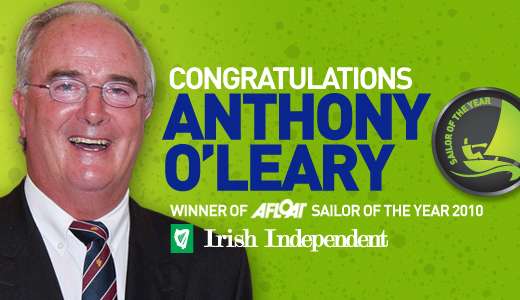
The O'Leary pace afloat and ashore belies his age of 53. During 2010, it was in May that he was "Sailor of the Month" for an already remarkable list of wins with his Ker 39 Antix. Having topped the April Series in Kinsale, he then won the Crosshaven-Dun Laoghaire race overall, went on to win his class and be one of the top points scorers in the ICRA Nationals in Dublin Bay, and then went on to Scotland to win his class overall with a nail biting brace of wins on the final day of the Scottish Series.
To achieve all that before May was out was exceptional, but the O'Leary progress was only beginning. The big picture was to maintain momentum towards the international Commodore's Cup in the Solent in August. Antix was one of the three boat squad, and her skipper was also the team captain in a campaign which was light years away from the glossy efforts which dominated the boom years of Irish affluence.

Anthony O'Leary takes on the waves at the helm of his yacht Antix during Cork week in Cork Harbour. Photo: Bob Bateman
In previous seasons, Ireland had been able to muster enough boats for two or even three teams, yet had never won despite being within inches of success. But this time round, only three boats were game for it, and only one – Rob Davis's Corby 36 Roxy – was new. Yet with Dave Dwyer's ever-keen Mills 39 marinerscove.ie filling the third slot, O'Leary headed a potent force, and he himself sailed with style and inspiring sportsmanship to give Ireland a commanding overall win.
Anthony O'Leary is the personification of Irish sailing at its very best. With the enthusiastic support of his wife Sally, he is father to a family which has logged outstanding sailing success at all levels. Yet he himself is in many ways the quintessential club sailor. He is as happy racing the Autumn series at Crosshaven with a 1720 or the West Cork regattas with a cruiser-racer, as he is competing at the highest levels. He has been among the front runners for the title of Ireland's "Sailor of the Year" several times. And now, as with all his wins, when he does do it, O'Leary does it with style.






























